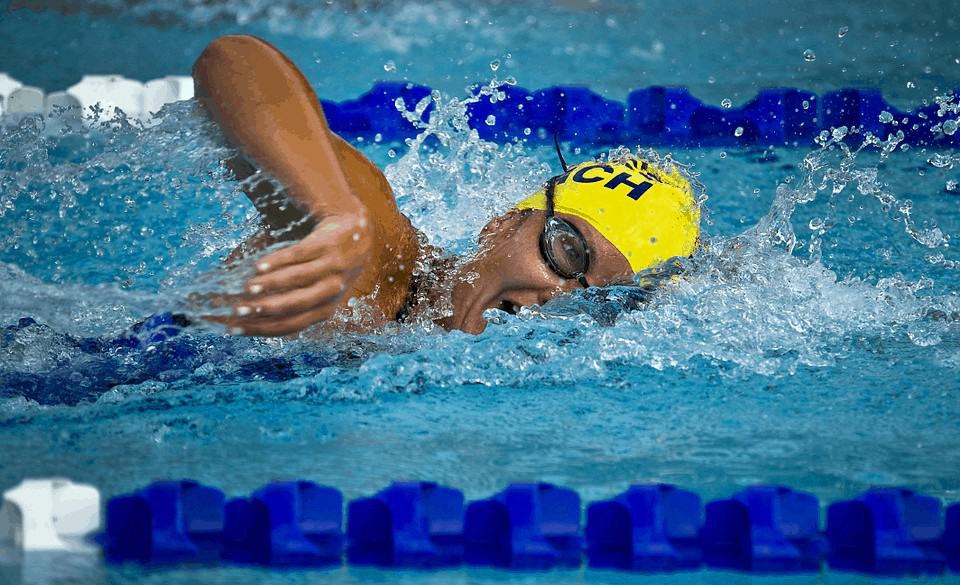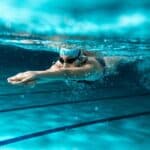
Total Immersion Sweet Spot Drill – UPDATED 2021 – A Complete Guide
Page Contents
Total immersion is a training method used by swimmers to improve performance by practicing how to glide efficiently through the water. This swimming method was introduced by Terry Laughlin, a coach and multiple championship winner. It is a method where the swimmer maintains a balanced and streamlined body rather than fighting the water.
In this guide, we discuss how you can find the natural point of balance when swimming. We talk about the total immersion sweet spot drills and exercises to help you use this method to improve your swimming performance.
Total Immersion Sweet Spot – Getting Started
Total immersion swimming focuses on the importance of comfort and efficiency. This method uses a number of drills to help the swimmer improve body position and balance while developing a better feel. In contrary to traditional techniques that focus on lap counts, total immersion swimming is more about mindful practice.
In this method of swimming, you focus on sustaining a streamlined body position in the water. You use the shifts in the core to propel through the water. Instead of fighting with water, you use your natural ability to float and swim in harmony with water. Here are the steps to getting started with total immersion sweet spot technique.
Balance
This skill is the most essential to have a sense of control over the body in the water. When you realize that you can control the sensation of sinking, you can easily align with the idea of controlling body position. Balance is the core of the total immersion technique upon which all other skills are based. When swimming out in the open-water, this skill can help prevent the fear of drowning.
Total Immersion Sweet Spot Drills
Sweet spot drills are about learning how to find the natural balance point of the body when using the total immersion technique of swimming. During the crawl or front stroke, the swimmer should rotate his torso to the side in such a way that the face can clear the water and can breathe.
The drill starts by floating on the back with the arms at the sides. The swimmer then rotates the body to have one side from the shoulder to the hand out of the water. This ensures the mouth and nose are out of the water which allows you to keep breathing. It then involves keeping the feet and hips light while gently kicking while you glide through the water. The drill can be repeated for the other side in a similar way.
It is important for the swimmer to involve their core, as this helps them to adjust the head and maintain balance until the drill comes as a natural movement.
The hand-lead sweet spot drill is another total immersion training that helps perfect breathing. This drill starts with the same position as the sweet spot drill. In this drill, you move the arm on the side of the body submerged in water. You should focus on keeping the ear on that side near the shoulder. When the ear and shoulder move away, you start sinking. Such a connection is vital for freestyle swimming.
Total Immersion Exercises & Balance Drills
Fish Drill
Fish drill is used to practice and improve kicking. This drill helps maintain buoyancy in water by using the lungs for natural flotation. To do this drill, you start with the sweet spot and rotate the head so it faces down into the water. The nose should then point to the bottom of the pool. The shoulders can rotate slightly but you should try to stay sideways in your initial sweet spot drill position.
If the position is correct, your hips and legs naturally rise to the surface. Your body floats on the water and you can keep kicking slowly. If you start sinking, you can lean into the chest and allow the legs and hips to float to the surface. The fish drill is aimed at improving the alignment and give you an idea of how you should position the head and neck while swimming.
Skating Position
This drill focuses on developing the feel for lengthening the body in the water. This is done by creating a line from the tips of the fingers to the tips of the toes through the spine. To do this drill, begin in the position of sweet spot drill. Then, extend the underwater arm in a way that it makes a straight line with the rest of the body.
Make sure the hand is only an inch below the water surface. The underwater ear should be kept near the shoulder. Next, roll the head up to break the water and breathe. You can kick the length of the pool gently and repeat the drill for another side.
Total Immersion Criticism – Is It Worth The Effort?
Total immersion has faced a lot of criticism by coaches and professional swimmers through the years. The first concern about it is that it teaches slow swimming. However, it is felt only by those who have done only a few drills and couldn’t reach the other end faster. The highest criticism is that total immersion focuses too much on the glide.
Another concern with the side to side rotation in total immersion technique is that excessive rotation slows down the stroke. Some people also criticize the principle of no kicking as they consider kicking to be essential for fast swimming.
These methods focus on using drills to become better. However, they are criticized as not being the ideal substitute to fast training.
Despite these criticisms, total immersion is a great way to help swimmers overcome the anxiety they experience when using traditional methods to improve their performance. Distance swimmers and triathletes can use this technique to converse energy. Practicing the total immersion sweet spot drills helps to master the feel of the water, in turn making the beginner a better swimmer.



